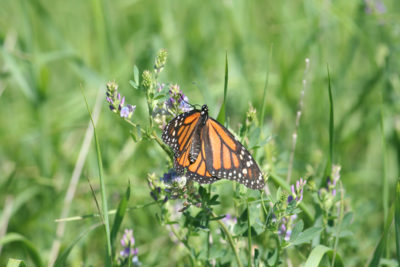
With its striking orange and black coloring and transcontinental range, the monarch butterfly is probably the most recognizable insect in North America. All pollinators are important to maintaining our food supply, but monarchs also have a key role in education; for decades schoolchildren across North America have been raising and releasing monarchs as part of their science lessons. Unfortunately, while monarchs were once one of the most commonly seen pollinators in gardens and fields, in the past decade there has been a precipitous drop in the monarch population. Just last week the World Wildlife Fund, in conjunction with the Monarch Butterfly Biosphere Reserve in Mexico, released the latest monarch population estimate– a number that was the second lowest on record for the population1.
The annual estimates of the monarch population are taken at the monarch’s overwintering site in central Mexico. Most of the monarchs in North America live east of the Rocky Mountains, and each fall they migrate thousands of miles south to their overwintering location in Mexico, where they cluster together on oyamel fir trees. In the spring those same monarchs fly north, where they produce new generations that spread throughout the United States and Canada. Their vast summer range can make it difficult to get precise estimates of the population size, but in winter the monarchs are bunched tightly together, making population estimates more feasible. Instead of counting individual monarchs, scientists record the amount of land that the overwintering monarch population covers.
This year, the monarchs covered 1.13 hectares; that’s a little more than two football fields’ worth of land. That might sound like a staggeringly small size, but it’s actually a 69 percent increase over last year’s population, which was the smallest on record. This increase offers some hope to counterbalance the fact that the current population size is the second smallest on record, but there is still much concern about the monarch. In fact, the US Fish & Wildlife Service is currently evaluating the monarch for listing as Threatened under the Endangered Species Act.
A listing would provide the monarch with legal protections, but a decision is not expected for at least a year, and in the meantime, there are many things that the public can do right now to help monarchs!
Planting native nectar plants and native milkweed, the only plant on which monarchs will lay eggs, is an easy way to help, but people who want to get more involved will find a whole host of monarch citizen science projects in need of volunteers. These projects study monarchs as they migrate and reproduce in the United States and Canada, and provide insight into how disease, climate change, and habitat loss are affecting the monarch population. Citizen science is so important to monarch research that since 2000, almost two-thirds of the published results on monarch field research have used citizen science data2. University of Minnesota Professor Karen Oberhauser, who heads the Monarch Larva Monitoring Project, emphasizes the need for continued participation in monarch citizen science projects.
“As the monarch population becomes smaller, it is important that we continue these efforts, even if it’s not as much fun to monitor something that we don’t see as often,” said Oberhauser. “We need to understand what’s driving the declines, and, hopefully, what drives future increases.”
If you’d like to help with the ongoing research into monarch conservation, check out these projects:
Monarch Larva Monitoring Project– Volunteers from across North America regularly monitor milkweed plants for monarch eggs and larvae, in order to understand variations in the monarch population. Some volunteers rear wild caught monarchs and record rates of parasitism.
Project Monarch Health– Participants carefully take scale samples from adult monarchs to test for the presence of a widespread parasite called OE. Sampling doesn’t hurt the monarchs, and it’s easy to do.
Journey North– People from across North America help track the monarch’s spring and fall migrations by entering observations online. Anyone who sees a monarch is encouraged to log the sighting with Journey North, which then creates interactive maps of the migration.
Monarch Watch– Volunteers with this project place small, lightweight tags on monarch wings. When monarchs with those tags are recovered, Monarch Watch can track how far monarchs travel.
Western Monarch Count– Most monarchs along the West Coast don’t migrate to Mexico; instead, they overwinter in California. Every November and December, volunteers are needed to count overwintering monarchs.
1Monarch Joint Venture. http://monarchjointventure.org/news-events/news/2015-population-update-and-estimating-the-number-of-overwintering-monarchs
2 Ries, L., and K. S. Oberhauser. In press. A citizen-army for science: Quantifying the contributions of citizen scientists to our understanding of monarch butterfly biology. Bioscience.
Photo courtesy of Wendy Caldwell.
Eva Lewandowski is a PhD candidate in the Conservation Biology Graduate Program at the University of Minnesota. She is part of the Monarch Lab, where she studies citizen science and conservation education.

